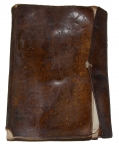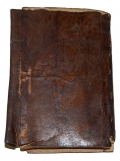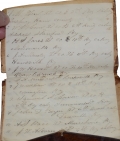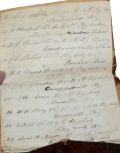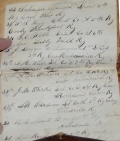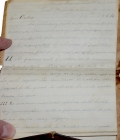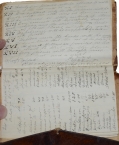site search
online catalog
NOTEBOOK OF CAPTAIN THOMAS B. MARTIN, HOLCOMBE’S SOUTH CAROLINA LEGION (LATER THE 7TH SOUTH CAROLINA CAVALRY); ONE OF THE “IMMORTAL 600”

$4,500.00 SOLD
Quantity Available: None
Item Code: 846-173
This leather-bound notebook with original closure string attached was kept by Captain Thomas B. Martin of Company “I”, Holcombe’s South Carolina Legion, which later was designated as the 7th South Carolina Cavalry. Captain Martin was captured at Stoney Creek Bridge, Nottaway County, Virginia on May 7, 1864. He was held a prisoner at Fort Delaware and transferred to Charleston (first to Morris Island and later to Fort Pulaski, Georgia), where he became one of the 600 Confederate officers who were exposed to friendly Confederate artillery fire and became famously known as the “Immortal Six Hundred.” Martin’s unique notebook contains the names, ranks, units and hometowns of at least 23 men who were members of the Immortal 600.
THOMAS BOOKER MARTIN
Thomas Booker Martin was born near the town of Fair Forest, Spartanburg County, South Carolina on May 25, 1833. His parents were John Polly Martin and Elizabeth Bomar Martin. John P. Martin and his twin brother (Thomas) had moved to South Carolina from Virginia with their grandmother, Mrs. William High, their mother having died while the two boys were infants. Father Martin grew up to be a farmer and his son, Thomas B. Martin—named for John P’s brother—also farmed as an adult in Spartanburg County. In addition to farming, young Thomas also learned the cabinet trade from his father and also worked as a house painter before the Civil War.
Before the war he married Nancy Ann Finch (1837-1926) and the couple was blessed with nine children, three boys and six girls, including Tahlula (“Lulu”), born at the height of her father’s service in Holcombe’s Legion in 1864. Thomas and Nancy were members of Oak Grove Baptist Church where Thomas served as a Deacon for upwards of thirty years.
In 1861 Thomas Martin enlisted at Spartanburg in Captain William P. Bishop’s company, and was appointed orderly sergeant. Bishop’s company, also known as the “Fort Prince Guards,” was incorporated into the Holcombe Legion, a mixed force of infantry (10 companies) and cavalry (5 companies) under Colonel P.F. Stephens. This unit was named for Lucy Holcomb, the wife of Governor Francis Wilkinson Pickens of South Carolina, and the Fort Prince Guards became Company “I” in the Legion’s infantry battalion. During the war Martin sported a dark beard that covered only his chin, a style that he kept until his death some sixty years later. A wartime photograph shows Martin in a long gray frock coat with two single rows of brass buttons and collar and cuffs trimmed in a separate color, almost certainly blue—signifying the infantry branch of service. His trousers appear to be dark blue or possibly black and he also is wearing a gray kepi.
Martin spent the first months of his military service at Camp Walsh, near Adams Run, South Carolina and it was here that the Holcombe Legion was mustered into Confederate service on November 13, 1861. In February 1862 the Legion moved to Camp Blair, near Adam’s Run, S.C., and later to Camp Carter, a new bivouac in the same general area.
In April of 1862 the Holcombe Legion was ordered to Virginia, where it participated in the Seven Days Campaign and the Battle of Second Manassas, where Martin’s brother, J. W., was mortally wounded. Following the Seven Days Campaign, the infantry and cavalry of Holcombe Legion were separated (July 1862) never to serve together again. The mounted companies of the legion would be increased in March 1864 to form the 7th South Carolina Cavalry.
As for Orderly Sergeant Thomas Martin, during the Peninsula and Seven Days campaigns he had remained in South Carolina, the result of a bout with typhoid fever. It would not be until after the Maryland Campaign (September 1862) that Martin would rejoin his company. Soon afterwards the officers of his company resigned and a new election of officers was ordered, at which time Thomas Martin was elected captain of Company I.
In 1863 the Holcombe Legion was ordered to join the army of Joseph E. Johnston in the western theatre of operations, but was transferred to Georgia following the actions at Big Black River and Jackson, Mississippi. In early May of 1864 Martin’s 7th South Carolina Cavalry was sent to Virginia and companies I and K were detached under the command of Major Martin Govan Zeigler to Stoney Creek Station in Nottaway County, some miles south of Petersburg. While guarding a railroad bridge over the Nottaway River, Martin and most of his company were captured on May 7th. Captain Martin and his men were unhorsed and forced to march all night to City Point (modern day Hopewell, Virginia) at the confluence of the Appomattox and James Rivers. From there they were packed onto a steam boat and taken to Fort Monroe where they spent the night. The following morning they were conveyed north. They marched through Washington, D.C. and on to the prisoner of war camp at Point Lookout, Maryland.
After five or six weeks at Point Lookout, Captain Martin, Major Ziegler and other officers were sent to Fort Delaware, a large Union prison located on Pea Patch island at the confluence of the Brandywine and Delaware rivers, some 15 miles south of Wilmington (Del.) Upon arrival, on or around June 25, the prisoners were again searched. This time, Martin lost his pistol but was able to save his gold watch by fastening the chain to his underwear (“drawers”) button. The commander of the garrison at Fort Delaware was Brig. Gen. Albin F. Schoef. Although ultimately responsible for the approximately 10,000 prisoners there, it was Schoef’s adjutant, George W. Ahl, and Lieutenant George Wolff who actually ran the prison. These two men were considered by the prisoners to be abusive and unfair.
On August 1, 1864 a newly arrived group of Confederate officers caught Thomas Martin’s attention. On that day more than 127 Rebel officers arrived at Fort Delaware who had served in Gen. John Hunt Morgan’s command and had been captured during Morgan’s 46-day raid into Indiana and Ohio. The officers who arrived at Fort Delaware on August 1st represented Morgan’s various regiments and hailed from Kentucky, Virginia, Texas, Tennessee, Alabama and Georgia.
For whatever reason he did so, Thomas Martin carefully recorded the names of Morgan’s officers in a roughly 3.5” x 5.5” leather-bound notebook. Martin listed each officer by name and rank, along with the regiment in which they served and even their home town. He also numbered the names (in no particular order) and titled the 25-page entry, “List of officers with their addresses also their comds Gen Morgan’s command this 1st Day August 1864.” Although Martin’s initial list contains the 127 officers from Morgan’s command, four additional names seem to have been added later, making a total of 131 names that appear in Martin’s notebook. Captain Martin’s own name and rank have also been written on the inside cover of the notebook, though his name is written in pencil while the list of Morgan’s officers, as well as the four added names, were written in ink.
MARTIN’S NOTEBOOK
In addition to the 131 names recorded in Captain Martin’s notebook, there are several interesting and distinct sections that cover the period between August 1 and October 24, 1864. These sections all relate to Martin’s captivity in South Carolina and Georgia as one of 600 Confederate officers sent to Charleston in August of 1864. These unfortunate officers were used as “human shields” in retaliation for a similar number of captured Federal officers who were then being confined in Charleston to discourage the shelling of that city by Yankee artillery. At least 23 officers listed in Captain Martin’s notebook, along with Martin himself, would become part of this group which eventually became known to history as “The Immortal 600.”
MORRIS ISLAND
On August 20, 1863 the two-masted steamer Crescent City left Fort Delaware with Captain Martin and 599 additional Confederate officers bound for the Federal-occupied Morris Island, guarding the mouth of Charleston Harbor. The men were packed into the ship’s fetid hold in which temperatures elevated mercilessly in the blistering sun. Lt. George Finley of the 56th Virginia recalled that the men were forced to sit in “total darkness without any clothing and drenched with perspiration.” For sustenance, the men were given “but a few crackers with a bit of suit beef or bacon.” Many, if not all of the men, suffered from seasickness as well.
Arriving in Port Royal, South Carolina, the men remained on board the Crescent City while their stockade was completed on Morris Island.
The prisoners were confined within a stockade located near Fort Strong, between Fort Gregg and Battery Wagner, where attempts to shell the Yankee fort could easily fall among the 600 officers selected to serve, in effect, as human shields. Upon the prisoners’ arrival a set of “rules and regulations” was issued by Yankee Headquarters at Morris Island on September 7, which Captain Martin duly recorded in his notebook . These rules and regulations were issued by Colonel William Gurney, 157th New York, and laboriously copied in ink by Captain Martin and saved in his notebook.
On October 21 Captain Martin and the other prisoners were moved off Morris Island to a camp at Fort Pulaski, near Savannah, Georgia. The prisoners arrived on October 22, 1864 and two days later orders were again issued a directive that delineated seventeen articles of rules and regulations under which the prisoners were to be governed. Once again, Thomas Martin recorded those regulations in his now dog-eared notebook.
In March of 1865 the surviving members of the Immortal 600 were sent back to Fort Delaware, where they arrived on March 12th. Along the way 13 captive officers (including two colonels) attempted an escape. Their plans were discovered, however, and the men spent the remainder of the voyage below decks in the ship’s brig.
Captain Martin later recalled that his health was so bad at that time that he remembered neither leaving Fort Pulaski nor the ocean voyage north. Martin’s comrades and “intimate friends” who had remained at Fort Delaware during 1864-65 failed to recognize him in his frail and deteriorated state. At Fort Delaware he suffered with pleurisy that kept him “prostrated for days and nights,” while he remained bedridden in a wooden bunk with a ‘mattress” made of a folded blanket. In time, however, Martin regained some of his strength and developed something of a craft business within the prison, making and selling jewelry such as watch chains, charms and finger rings from sticks of gutta-percha which he purchased from Yankee sutlers. By now the survivors were becoming famous for their adherence to principle and refusal to take the Oath of Allegiance to the Federal government and to accept life-saving paroles.
In April news was received of Lee’s surrender and Lincoln’s assassination, but Captain Thomas B. Martin would not be released until July 16, 1865. He would then endure a circuitous journey of several weeks or more which took him to New York City. Eventually he made his way back to Fair Forest where it is said he found his family to be in mourning, six months having passed since they had received his last letter.
MARTIN’S POST-WAR LIFE
Thomas B. Martin returned to Fair Forest, where he lived out his days in peace. He was a longtime deacon at oak Grove Baptist Church, where he served the congregation for more than 30 years. As a post-war vocation he again took up painting, but he also farmed in Spartanburg County and ran a public cotton gin and saw mill in the Fair Forest area. Martin never forgot his wartime captivity. In later years he became an active member of the “Immortal 600 Society,” in which he was elected to the Executive Committee in 1910. He was listed as the last Civil War pensioner in Spartanburg County in 1919. Martin died on April 13, 1922 and was buried in Fair Forest Baptist Church Cemetery. Nancy martin died four years later and now lies beside him. The Martin’s last known surviving child, Tahlula, passed away in 1952 at the age of 90. In recent years Captain Martin’s grave has been tended by Mr. Dan Smith under the auspices of the “Guardian” program developed by the Sons of Confederate Veterans. This program authorizes approved individual volunteers to care for and protect the graves of Confederate soldiers throughout the South.
Today a monument to the Immortal 600 stands at Fort Pulaski National Monument in Savannah. This monument, authorized by the National Park Service in October of 1995, honors the Immortal 600 and recognizes the thirteen prisoners who died there after being transferred from Morris Island. Thankfully, the graves of these men have also recently been identified.
THE NAMES OF OFFICERS IN MARTIN’S NOTEBOOK THAT WERE SENT TO MORRIS ISLAND AS HUMAN SHIELDS
By matching the readable names in Martin’s notebook I have been able to identify at least 23 (and possibly 24) officers who would be sent to Charleston and exposed to friendly artillery fire. Miraculously, while a number of these men died of disease, none were killed by the shells that exploded overhead or by the several mortar shells that fell in their midst and failed to explode. The alphabetical list of these “Immortal 600” officers (as numbered by Martin) are as follows:
#84—2nd Lt. Marcus L. Aldridge, Co. B, 3rd Kentucky Cav.
#113--Capt. William D. Ballantine, Co. A, 2nd Florida Infantry
#118—1st Lt. John B. Baxter, Co. F, 23rd Arkansas Infantry
#110—Capt. John L. Brent, Co. F, 18th Arkansas Infantry
—Capt. Gilbert R. Campbell, 21st Tennessee Cavalry (company unknown/unnumbered by Martin)
#119—Capt. George K. Cracraft, Co. G, 23rd Arkansas Infantry (Martin spells in “Craicraft”)
#2—1st Lt. William F. Crow, Co. B, 6th Kentucky Cavalry
#29--1st Lt. Benjamin S. Drake, Co. M, 2nd Kentucky Cavalry
#76—11st Lt. Hugh F. Dunlap, Co. B, 10th Kentucky Cavalry
#70--2nd Lt. William B. Ford, Co. D, 8th Kentucky Cavalry
#72--1st Lt. Isham A. Fox, Co. B, 11th Kentucky Cavalry
#59—Capt. Thornton M. Hammack, Co. D, 10th Kentucky Cavalry
#16—2nd Lt. Robert B. Haynes, Co. A, 3rd Kentucky Cavalry
#64—2nd Lt. George W. Hunter, Co. G., 8th Kentucky Cavalry
#81—22nd Lt. John W. Hughes, Co. K, 44th Virginia Infantry (Listed in Martin’s notebook as Lt. in 6th Kentucky Cavalry; this may be an error.)
#100—2nd Lt. William F. Leathers, Co. A., 2nd Kentucky Cavalry
#121—1st Lt. Joseph J. Maddox, Co. B., 38rd Georgia Infantry
—Capt. Thomas B. Martin, Co. I, Holcombe’s (SC) Infantry Legion (no number; writer)
#15—2nd Lt. J.O. Meadows, Co. A, 3rd Kentucky Cavalry
#77--1st Lt. Hanson Moles, Co. F, 7th Kentucky Cavalry (Martin list his first name as “Handsel”)
#67--2nd Lt. James D. Morris, Co. D, 8th Kentucky Cavalry
#34--1st Lt. George C. Nash, Co. K, 6th Kentucky Cavalry Martin list him in Co. I)
#7---Capt. Almarine A. Norris, 14th Kentucky Cavalry (company unknown)
#53—2nd Lt. David N. Prewitt, Co. A, 6th Kentucky Cavalry
#41—2nd Lt. Charles E. Richards, Co. D, 5th Kentucky Cavalry
The one major discrepancy on this list related to #81.
~~~~~~~~~~~~~~~~~~~~~~~~~~~~~~~~~~~
THIS ITEM, AS WITH ALL OTHER ITEMS AVAILABLE ON OUR WEB SITE,
MAY BE PURCHASED THROUGH OUR LAYAWAY PROGRAM.
FOR OUR POLICIES AND TERMS,
CLICK ON ‘CONTACT US’ AT THE TOP OF ANY PAGE ON THE SITE,
THEN ON ‘LAYAWAY POLICY’.
THANK YOU!
Inquire About NOTEBOOK OF CAPTAIN THOMAS B. MARTIN, HOLCOMBE’S SOUTH CAROLINA LEGION (LATER THE 7TH SOUTH CAROLINA CAVALRY); ONE OF THE “IMMORTAL 600”
For inquiries, please email us at [email protected]
Most Popular
Historical Firearms Stolen From The National Civil War Museum In Harrisburg, Pa »
Theft From Gravesite Of Gen. John Reynolds »
Cavalry Carbine Sling Swivel »
Fine Condition Brass Infantry Bugle Insignia »
featured item
RARE IDENTIFIED 65th NY SERGEANT’S JACKET, WITH MANSCRIPT MATERIAL: 1st U.S. CHASSEURS
This is an extremely rare, early-war uniform jacket, with related material, belonging to a sergeant of the 65th New York, who enlisted at the beginning of the war as the regiment’s commissary sergeant, and gained a lieutenant’s commission in a… (1179-233). Learn More »



